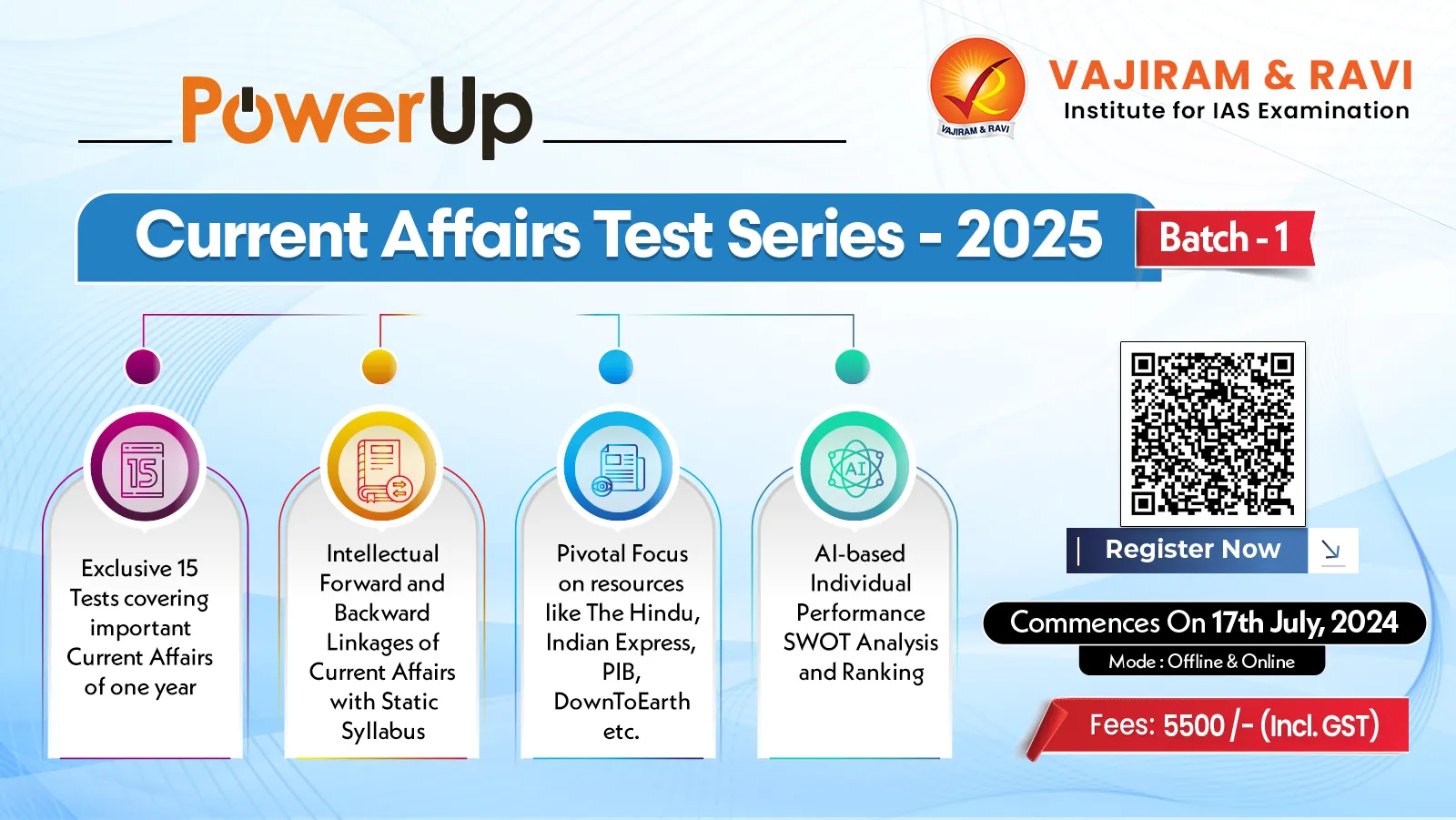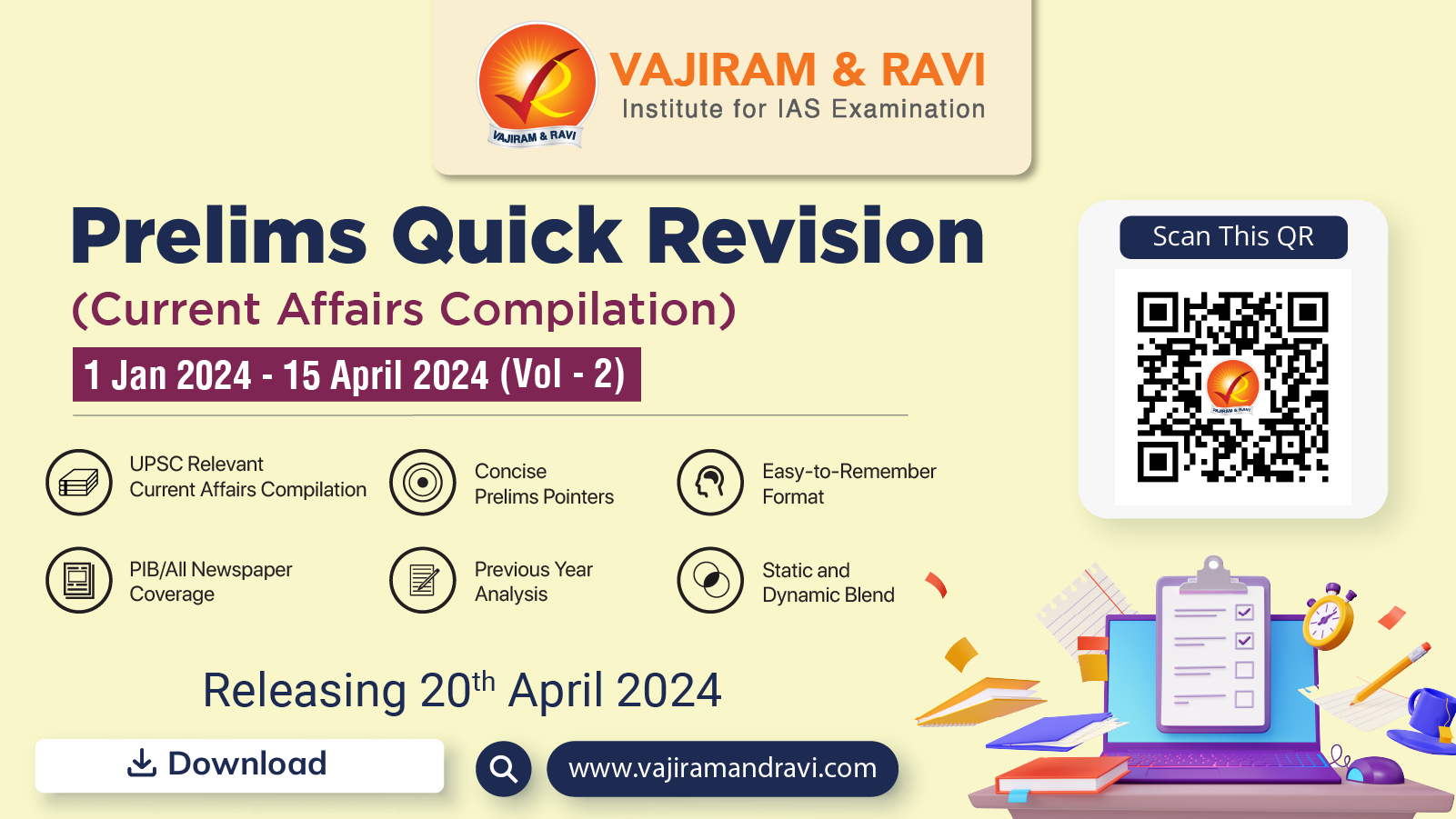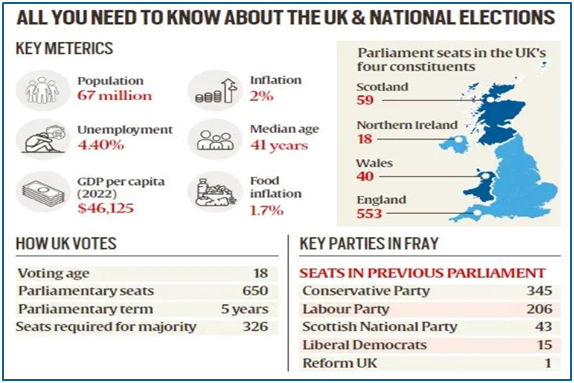Upcoming Mentoring Sessions
MSP 24- Polity Test 1
Mentoring Sessions (2024-25) - How to Choose Optional?
Mentoring Sessions (2024-25) - How to DO REVISION?
RMS - Art & Culture - Current Affairs 2023-24
RMS - Art & Culture - Architecture 2
RMS - Polity - DPSP & FD
RMS - Medieval History - Delhi Sultanate
RMS - Polity - Parliament 3
RMS - Geography - India Mapping
RMS - Art & Culture - Architecture 1
Mentoring Sessions (2024-25) - How to Start Preparation?
RMS - Geography - World Mapping
RMS - Ancient History - Guptas to Harshvardhana
RMS - Polity - Parliament 2
Prelims 2024 Strategy Session
RMS - Ancient History - Mauryan and Post-Mauryan Age
RMS - Polity - Parliament 1
RMS - Geography - Major Landforms
RMS - Polity - Judiciary - 2
RMS - Economics - Money and Banking - 2
Mentoring Session (2024-25) - How to Make Notes?
RMS - Polity - Judiciary 1
General Mentoring Session (GMS ) 2024-25
RMS - Modern History - Constitutional Developments - Important Acts in British India
RMS - Ancient History - Buddhism and Jainism
RMS - Economics - Human Resource and HRD
RMS - History - Ancient India - Mahajanpadas
RMS - Economics - Balance of Payment and Foreign Trade
Mentoring Session (2024-25) – How to Read and Analyse Newspaper?
Mentoring Session (2024-25) - How to write an Answer?
RMS - Economics - Money and Banking-I
Article
04 Jul 2024
Context
- With a new government at the Centre, the economic policy discourse has now shifted to speculating about the Union Budget for 2024-25 and this year’s budget is especially important for one specific reason.
- In an unexpected turn of events, the RBI announced last month that it is transferring a sizeable dividend to the government, significantly more than what was anticipated.
- This has triggered much discussion about how the government can spend this windfall and there is a need to explore more fundamental question whether the government should spend it at all.
Fiscal Management Principles and Their Purpose
- Fiscal Management Principles
- Fiscal management should be guided by two general principles. First, deficits should be kept at prudent levels.
- In India, that level should ideally be around three per cent of GDP for the Centre according to the long-standing Fiscal Responsibility and Budget Management (FRBM) Act.
- Second, governments should spend a bit more than this norm when the economy is doing badly and a bit less when the economy is doing well.
- Purpose: Stabilising the Economy through Deficit Variation
- The purpose of varying the deficit, as specified by the second principle, is to stabilise the economy.
- In bad times, when private sector demand is falling, the government needs to step in and boost demand to prop up the economy.
- The needs are reversed when the economy starts to recover and as private demand revives, the government needs to curtail its spending lest overall demand races ahead of supply, fostering inflation.
- A critical aspect of this second principle is that policies must be symmetric.
- Larger-than-normal deficits need to be followed by smaller-than-normal deficits so that government debt gets stabilised instead of spiralling upwards.
An Analysis of India’s Struggle with Fiscal Management
- Historical Context of Fiscal Deficit
- From 2000-01 to 2019-20, India’s average fiscal deficit stood at 4.6% of GDP.
- This figure starkly contrasts with the 3% target set by the Fiscal Responsibility and Budget Management (FRBM) Act, a legislative framework aimed at ensuring fiscal prudence.
- The FRBM Act was introduced in 2003 with the goal of reducing India's fiscal deficit and ensuring long-term macroeconomic stability.
- Despite this, successive governments have struggled to adhere to the 3% norm, often citing various economic challenges and development needs.
- Structural Issues and Economic Pressures
- Several structural issues and economic pressures have contributed to India's struggle with fiscal discipline.
- These include a growing population, significant developmental needs, and political pressures to increase spending on social welfare programs.
- Additionally, India's tax base remains relatively narrow, with challenges in tax collection efficiency and compliance.
- These factors have often led governments to resort to borrowing, thereby increasing the fiscal deficit.
- Pandemic-Induced Fiscal Challenges
- The COVID-19 pandemic further exacerbated India’s fiscal challenges.
- The economic shock induced by the pandemic necessitated substantial government intervention to support businesses and individuals. In response, the fiscal deficit ballooned to 9.2% of GDP in 2020-21.
- This surge was a necessary response to the unprecedented crisis, aimed at providing a safety net for the economy.
- However, the subsequent recovery phase has seen a slower-than-expected reduction in the deficit.
- Post-Pandemic Fiscal Policies
- Post-pandemic, the government's efforts to bring down the deficit have been sluggish.
- The Interim Budget for 2024-25 set a deficit target of 5.1%, which remains significantly higher than pre-pandemic levels and the FRBM target.
- This slow adjustment reflects the complexities of balancing economic recovery with fiscal prudence.
- Persistent high deficits indicate underlying issues in fiscal management and the difficulty in reining in spending after periods of high expenditure.
RBI’s Unexpected Dividend and Debate on Increasing Capital Expenditure
- The RBI announced last month that it will transfer Rs 2.11 lakh crore to the central government as dividend, double the amount that had been budgeted.
- The crucial question now is that what the government should do with this unexpected bounty.
- According to some commentators, the government should increase its capital expenditure (capex).
- As per the Interim Budget, the capex growth rate is supposed to slow down in 2024-25.
- But now with this surplus dividend, the government may be tempted to step up its capex That would be a mistake.
The General Sentiment on Capex, Purpose of Capex Spending, and the Assessment of the Necessity of Capex
- The Sentiment on Capex
- The general sentiment in India seems to be that any spending on capex is great news which is not correct.
- China, for example, as part of their infrastructure building spree, built two to three airports in the same city and are now struggling to repay the debt that was incurred for these projects.
- What is therefore needed in India is to calculate how much capex is truly needed and of what kind.
- The Purpose of Capex Spending
- Governments spend on capex for two reasons: To stimulate growth and to meet the needs of the economy.
- Infrastructure in India is definitely a problem that needs to be solved. But not all at once.
- Since the pandemic, the government’s capex spending has been growing at an average annual rate of 30 per cent.
- It is not obvious that this pace needs to be increased, or even sustained. On the contrary, recent developments demonstrate that the speed of construction and focus on new projects, rather than maintenance has serious downsides.
- Assessing the Necessity of Capex
- In addition, not all capex is essential for growth, for example, using Rs 1.6 lakh crore to revitalise telecom MTNL and BSNL is surely not critical.
- It is not critical especially when affordable cell phone services are being provided throughout the country by private operators.
- Likewise, it is not obvious that spending lakhs of crores on bullet trains can be justified in a country whose per capita income is less than $2,500.
Way Forward: Analysing the Need for Economic Stimulation
- The government must analyse the need to stimulate an economy that is doing so well.
- Given the strong economic performance, it should instead use the surplus dividend from the RBI to bring the fiscal deficit down closer to three per cent.
- There is, however, a caveat to this discussion and this relates to the true state of the Indian economy.
- If the economy is weaker than what the 7-8 per cent growth figures suggest, only then there may be a case for the government to keep spending to support the economy.
Conclusion
- India’s struggle with fiscal discipline is a complex issue rooted in structural challenges and exacerbated by economic shocks such as the COVID-19 pandemic.
- While the government has made efforts to manage the fiscal deficit, sustained high deficits and rising debt levels highlight the need for deeper structural reforms and a stronger commitment to fiscal prudence.
- Achieving this balance is crucial for ensuring long-term economic stability and growth.
Article
04 Jul 2024
Why in news?
The United Kingdom is all set for a crucial general election today (July 4). Rishi Sunak, the current Prime Minister of the United Kingdom, called a snap general election for July 4, 2024, even though the next election was not required until December 2024.
Experts and polling data suggest a landmark election is imminent, with the Labour Party likely to end the Conservatives' 14-year rule.
What’s in today’s article?
- Nature of Parliament
- Nature of the Governance System
- Voting System of the United Kingdom
- What Labour’s win could mean for India-UK FTA?
Nature of the Parliament of UK
- The UK Parliament is a bicameral legislature, consisting of two houses:
- House of Commons
- The lower house, made up of 650 MPs elected by the public through FPTP.
- 533 for England; 59 for Scotland; 40 for Wales; 18 for Northern Ireland
- It is the primary legislative body, responsible for making and passing laws.
- The party (or coalition) with the majority of seats forms the government, and its leader becomes the Prime Minister.
- The opposition is made up of MPs from parties not in government.
- The lower house, made up of 650 MPs elected by the public through FPTP.
- House of Lords
- The upper house, which is unelected and includes life peers, bishops, and hereditary peers.
- It reviews and suggests amendments to legislation proposed by the House of Commons.
- While it can delay legislation, it cannot ultimately prevent bills passed by the Commons from becoming law.
- House of Commons
Nature of the Governance System
- The United Kingdom operates under a constitutional monarchy and a parliamentary democracy. Key features include:
- Monarch
- The head of state is the monarch, currently King Charles III.
- The role is largely ceremonial, with real political power vested in elected bodies.
- Prime Minister
- The head of government is the Prime Minister, who is the leader of the majority party in the House of Commons.
- The Prime Minister is appointed by the monarch and is responsible for running the government, making policy decisions, and representing the UK domestically and internationally.
- Cabinet
- Comprises senior government ministers chosen by the Prime Minister.
- Ministers are typically heads of government departments and are responsible for implementing government policy.
- Monarch
Voting System of the United Kingdom
- Background
- The House of Commons, Scottish Parliament, Welsh Parliament, Northern Ireland Assembly and UK local authorities use different voting systems.
- First-past-the-post
- The House of Commons, mayoral elections in England, Police and Crime Commissioner elections and local councils in England and Wales use the first-past-the-post system.
- Voters select their preferred candidate. The candidate with the most votes wins.
- Formation of the government
- If a single party wins a majority of the 650 seats, their leader will become the new Prime Minister.
- If no party achieves a majority, a hung parliament will be declared, and the largest party may attempt to form a coalition government.
- In this year’s election, the two main contenders for Prime Minister are Rishi Sunak of the Conservative Party and Keir Starmer of the Labour Party.
What Labour’s win could mean for India-UK FTA?
- Background
- India and UK have been negotiating a proposed free trade agreement (FTA) for more than two years to boost trade between the two nations.
- The agreement could result in a mutual tariff relaxation on a range of goods such as cars, clothes, alcoholic beverages, and medical instruments.
- However, a landslide victory for the Labour Party in the UK elections could lead to a change in the dynamic of the FTA negotiations.
- Political certainty might be beneficial for the deal
- Since the UK's unexpected referendum to leave the European Union, London has lacked the political stability needed to negotiate a trade deal with India, which has a high tariff regime.
- However, if Labour wins decisively, there might be enough political stability to sign such a deal.
- Growing support for India in the current Labour Party
- Under Keir Starmer, Labour party has changed. It is not the same party as that headed by his predecessor, Jeremy Corbyn, who called for international intervention in Kashmir.
- Starmer has recognised the growing political clout of the UK’s Indian origin population — the largest immigrant group in the country.
- Visas a likely sticking point
- Immigration remains among the most heated issues in British politics. This could be a sticking point for a trade deal with India.
- New Delhi is seeking temporary visas for its service sector workforce under the FTA — this is where it expects to gain the most in the deal.
- With the UK being a powerhouse in the IT and financial services segment, India’s service sector could benefit from the integration.
- But given the UK’s political climate, Labour is likely to negotiate hard on the visa issue.
- Immigration remains among the most heated issues in British politics. This could be a sticking point for a trade deal with India.
- Tougher negotiations on climate
- India will also likely face tougher negotiations on climate from a Labour government.
- India has sought a relaxation on the carbon tax that the UK is expected to implement along the lines of the EU.
- A carbon tax is a government-imposed price that emitters pay for each ton of greenhouse gas (GHG) emissions they release.
- New Delhi argued during the FTA negotiations that the proposed carbon border adjustment mechanism could take away much of the tariff concessions agreed during the FTA.
Article
04 Jul 2024
Why in news?
A study published in The Lancet Planetary Health journal found that air pollution is a major health concern in India.
In 10 of the largest and most polluted cities, including Delhi, Bengaluru, and Mumbai, 7.2 percent of all daily deaths were linked to PM2.5 levels. These levels were higher than the safe exposure guidelines set by the World Health Organization (WHO).
What’s in today’s article?
- WHO’s revised air quality guidelines 2021
- Key highlights of the reports
- Steps taken to control air pollution
WHO’s revised air quality guidelines 2021
- About
- In September 2021, the World Health Organization (WHO) has strengthened its air quality guidelines.
- The revised norms recommend air quality levels for six pollutants:
- Ozone, nitrogen dioxide, sulphur dioxide and carbon monoxide.
- The other two are PM10 and PM2.5 -- particulate matter equal or smaller than 10 and 2.5 microns in diameter.
- The recommended levels for all the six pollutants have been revised downwards from the existing norms that have been in place since 2005.
- Non-binding in nature
- The WHO norms are not binding on any country.
- These are only recommended norms considered safe for human health, backed by scientific studies. However, air quality does affect the international image of a country.
Key highlights of the study conducted by The Lancet Planetary Health journal
- Observations made w.r.t. Delhi
- 11.5% of annual deaths (around 12,000) are due to air pollution.
- This is the highest percentage for any city in India.
- Situation across 10 Major Cities
- Ahmedabad, Bengaluru, Chennai, Delhi, Hyderabad, Kolkata, Mumbai, Pune, Shimla, and Varanasi were included in the study.
- More than 33,000 deaths annually are attributed to air pollution.
- Shimla has the lowest pollution-related mortality burden, with 59 deaths annually (3.7% of total deaths).
- On average, 7.2% of all deaths in these cities are caused by air pollution.
- PM2.5 Exposure
- PM2.5 levels in these cities exceed WHO's safe limit (15 micrograms per cubic metre) 99.8% of the days.
- Data collected from civil registries between 2008 and 2019 for daily deaths.
- Over 3.6 million deaths examined.
- Researchers used a machine-learning-based exposure model for detailed PM2.5 data.
- Mortality and Pollution Levels
- Mortality increases by 1.42% for every 10 micrograms per cubic metre rise in PM2.5 levels.
- Less polluted cities showed a higher risk of mortality due to pollution increase.
- A spike in air pollution in Indian cities that have clean air may raise death rates higher than in cities that have higher pollution loads.
- Thus, the same increase in air pollution in, say, Bengaluru, can raise death rates more than in Delhi, which has much higher background levels of air pollution.
- Research Insights
- Cities with lower pollution levels, like Bengaluru and Shimla, showed stronger effects due to sharp risk increases at lower exposure levels.
- The study is a pioneering effort in understanding the relationship between short-term air pollution exposure and mortality in India.
- It offers new insights into the health impacts of air pollution in various agro-climatological zones of India.
Steps Taken by the Indian Govt
- National Clean Air Programme (NCAP)
- NCAP was launched in January 2019 to improve air quality through a city-specific action plan.
- Under NCAP, India has a target to reduce 20-30% of PM2.5 and PM10 concentrations by 2024 from 2017 levels.
- PRANA Portal
- It was launched to monitor the implementation of NCAP
- National Air Quality Index (AQI) –
- It was launched in October 2014 to disseminate information on air quality in an easily understandable form for the general public.
- The measurement of air quality is based on eight pollutants, namely, PM10, PM2.5, NO2, SO2, CO, O3, NH3, and Pb
- Under the authority of the Air (Prevention and Control of Pollution) Act of 1981, India’s Central Pollution Control Board sets national ambient air quality standards.
Current Affairs
July 4, 2024

About Indian Gaur:
- The Indian Bison of Gaur is the largest and tallest in the family of wild cattle.
- Scientific Name: Bos gaurus
- Distribution: Gaurs are indigenous to the South and Southeast parts of Asia.
- Habitat:
- Gaurs are primarily the denizens of evergreen and semi-evergreen forests along with moist deciduous forests with open grasslands.
- They prefer hilly-terrains below an altitude of 1,500-1,800 m with large and undisturbed forest tracts and abundant water.
- Features:
-
- The Indian Bison is about 240 cm to 340 cm in length, with a sole tail length of about 70 cm to 105 cm. Their height is about 170 cm to 230 cm.
- The adult male weighs around 600 kg to 1500 kg. and the adult female weighs about 400 kg to 1000 kg.
- They have a convex shape on the forehead.
- The limbs are very strong and sturdy.
- Both males and females possess horns. The horns are pale green or yellowish brown in color and are not pointed upward but possess a slightly inward curvature.
- They have a typically short tail.
- The Gaur is a social animal. They generally live in group size of about 30 to 40.
- Conservation Status:
- IUCN Red List: Vulnerable
- Wild Life Protection Act, 1972: Schedule I
- It is listed in CITES Appendix I.
Key Facts about Nagarjunasagar Srisailam Tiger Reserve (NSTR):
- Location: It is located in the Nallamala hill ranges(an offshoot of the Eastern Ghats) of Andhra Pradesh and spreads across the undivided districts of Guntur, Prakasam and Kurnool.
- It attained the status of a Tiger Reserve in 1983.
- This is the largest tiger reserve in the country, spreading over an area of 5937 Sq. Km.
- It is named after two major dams in the area, Nagarjuna Sagar Dam and Srisailam Dam.
- Two wildlife Sanctuaries, namely Rajiv Gandhi Wildlife Sanctuaryand Gundla Brahmeswaram Wildlife Sanctuary (GBM), constitute the Tiger Reserve.
- The river Krishna traverses through this Reserve for a linear distance of around 270 Kilometers.
- Topography: It consists of plateau, ridges, gorges and deep valleys.
- Vegetation: Tropical dry deciduous forests having an undergrowth of bamboo and grass.
- Flora: The habitat has several endemics like Andrographis nallamalayana, Eriolaena lushingtonii, Crotalaria madurensis Var, Dicliptera beddomei and Premna hamiltonii.
- Fauna:
- Top faunal species include Tiger, Leopard, Wolf, Wild Dogand Jackal.
- The prey species are represented by Sambar, Chital, Chowsingha, Chinkara, Mouse Deer, Wild boar and Porcupine.
- The river Krishna has Muggers, Otters and Turtles.
Current Affairs
July 4, 2024

About Money Mule:
- A money mule is someone who transfers or moves illegally acquired money on behalf of someone else.
- Criminals recruit money mules to help launder proceeds derived from online scams and frauds or crimes like human trafficking and drug trafficking.
- Money mules add layers of distance between crime victims and criminals, which makes it harder for law enforcement to accurately trace money trails.
- Money mules can move funds in various ways, including through bank accounts, cashier’s checks, virtual currency, prepaid debit cards, or money service businesses.
- Criminals will often use fake job adverts, or create social media posts about opportunities to make money quickly, in order to recruit potential money mules.
- Some money mules know they are supporting criminal enterprises; others are unaware that they are helping criminals’ profit.
- Money mules often receive a commission for their service,or they might provide assistance because they believe they have a trusting relationship with the individual who is asking for help.
- When such frauds are reported, the money mule becomes the target of police investigations.
- Even if money mules are not directly involved in the crimes that generate the money, they are accomplices, as they launder the proceeds of such crimes.
Article
04 Jul 2024
Why in the News?
Itihaasa, a non-profit organization, has recently published an assessment of India’s National Quantum Mission.
What’s in Today’s Article?
- About National Quantum Mission (Basics, Objectives, Focus Areas, Significance, etc.)
- News Summary
About National Quantum Mission:
- Union Cabinet approved the National Quantum Mission (NQM) in April 2023 at a total cost of 6000crores from 2023-24 to 2030-31.
- The mission aims to seed, nurture, and scale up scientific and industrial R&D, creating a vibrant and innovative ecosystem in Quantum Technology (QT).
- This initiative will accelerate QT-led economic growth, foster the ecosystem in the country, and position India as one of the leading nations in the development of Quantum Technologies & Applications (QTA).
Mission Objectives:
- Developing intermediate-scale quantum computers with 50-1000 physical qubits within 8 years using various platforms like superconducting and photonic technology.
- Satellite-based secure quantum communications between ground stations over a range of 2000 kilometres within India.
- Long-distance secure quantum communications with other countries.
- Inter-city quantum key distribution over 2000 km.
- Multi-node quantum networks with quantum memories.
Focus Areas:
- Developing magnetometers with high sensitivity in atomic systems.
- Creating atomic clocks for precision timing, communications, and navigation.
- Supporting the design and synthesis of quantum materials such as superconductors, novel semiconductor structures, and topological materials for the fabrication of quantum devices.
- Developing single photon sources/detectors and entangled photon sources for quantum communications, sensing, and metrological applications.
Mission Implementation:
- The mission implementation includes the establishment of four Thematic Hubs (T-Hubs) in top academic and National R&D institutes in the following domains:
- Quantum Computing
- Quantum Communication
- Quantum Sensing & Metrology
- Quantum Materials & Devices
- These hubs will focus on generating new knowledge through basic and applied research and promoting R&D in their respective areas.
Impact & Significance:
- NQM has the potential to elevate the country's technology development ecosystem to a level of global competitiveness.
- The mission will greatly benefit various sectors including communication, health, financial, and energy, with applications in drug design, space, banking, security, etc.
- The mission will also provide a significant boost to national priorities such as Digital India, Make in India, Skill India, Stand-up India, Start-up India, Self-reliant India, and Sustainable Development Goals (SDG).
Assessment report of National Quantum Mission:
- Itihaasa, a non-profit organization, has recently published an assessment of India’s National Quantum Mission.
- As per the assessment, India may have done the right thing by launching a Rs 6,000 crore-worth National Quantum Mission to develop some of the most sought-after technologies for the future.
- The assessment shows that India was just one among 17 countries to have a dedicated government programme to back research in quantum technologies, and one of the 12 to have committed separate investments for the purpose.
- However, the report cautions that India would have to overcome a significantly large gap that currently exists between its capabilities and those of other leading countries in these areas like the United States and China.
- India’s Spending = USD 0.75 billion
- China’s Spending = USD 15 billion
- United States’ Spending = USD 3.75 billion
- India was far behind of the United States and China in terms of patents obtained in quantum technologies till now, and in publications in top journals.
- The assessment report found about 110-145 Indian researchers, at the principal investigator level, already working on quantum technologies at major laboratories and institutions.
- About 75-100 Post-docs and 300-400 PhD students were working with them. In addition, there were about 50-100 MTech students in different areas related to quantum technologies.
- Also, India was producing the highest number of graduates in areas related to quantum technologies, the assessment found.
Current Affairs
July 4, 2024

About Nightjars:
- They are medium-sized nocturnal insectivorous birds in the family Caprimulgidae and the order Caprimulgiformes.
- These birds are found all around the world, with the exception of Antarctica and certain island groups, such as the Seychelles.
- Features:
- They are characterized by long wings, short legs, and very short bills.
- They feed on flying insects that they catch on the wing at night.
- Their grey-brown, mottled, streaked, and stripey plumage provides ideal camouflage in the daytime.
- During the day, they sleep on the ground or perched, usually lengthwise, on a branch.
- They are among the most difficult bird species to study due to their unobtrusive and nocturnal behavior and cryptic plumage.
Key Facts about Lesser Sunda Islands:
- The Lesser Sunda Islands are an archipelago in maritime Southeast Asia.
- It is located to the immediate east of Java and to the north of Western Australia.
- Major islands in the group include Bali, Lombok, Sumbawa, Flores, Sumba, and Timor.
- Together with the Greater Sunda Islands to the west, they make up the Sunda Islands.
- The islands are part of a volcanic arc, the Sunda Arc, formed by subduction along the Sunda Trench in the Java Sea.
Article
04 Jul 2024
Why in News?
Speaking to mark the Asteroid Day 2024 (June 30), ISRO Chairman emphasised the necessity of international collaboration in developing planetary protection systems against asteroids.
He also highlighted India's ambition and qualifications to join global missions focused on asteroid research and defence prior to the Apophis asteroid and Earth having a close encounter on April 13, 2029.
What’s in Today’s Article?
- What is Asteroid Impact Avoidance?
- India’s Journey in Planetary Defence
- India’s Future in Planetary Defence
What is Asteroid Impact Avoidance?
- It encompasses the methods by which near-Earth objects (NEO) on a potential collision course with Earth could be diverted away, preventing destructive impact events.
- An impact by a sufficiently large asteroid or other NEOs would cause massive tsunamis or multiple firestorms, depending on its impact location.
- A collision 66 million years ago between the Earth and an object approximately 10 km/ 6 miles wide is thought to have
- Produced the Chicxulub crater (buried underneath the Yucatán Peninsula in Mexico), and
- Triggered the Cretaceous-Paleogene extinction event that is believed to have caused the extinction of all non-avian dinosaurs.
- While the chances of a major collision are low in the near term, it is a near-certainty that one will happen eventually unless defensive measures are taken.
- In 2022, NASA spacecraft Double Asteroid Redirection Test (DART) impacted Dimorphous, reducing the minor-planet moon's orbital period by 32 minutes.
- This mission constitutes the first successful attempt at asteroid deflection.
- In 2025, China’s CNSA plans to launch another deflection mission to near-Earth object 2019 VL5, a 30-metre-wide (100 ft.) asteroid.
- This will include both an impactor and observer spacecraft.
India’s Journey in Planetary Defence:
- Observing Apophis:
- In 2004, Indian observatories were able to see an object that was 340 metres in size.
- They came to the conclusion that there is a substantial risk that this asteroid will reach and impact Earth.
- The object is known as Apophis, and its sphere is 360 days (almost one Earth year), and it can often be seen in the vicinity of Earth.
- On April 13, 2029, it will come to a distance of around 32,000 km away from Earth and there is a fear that if there is any change in gravity, it will have an impact on Earth in 2036.
- ISRO’s plans for Apophis:
- ISRO is looking to study the asteroid in 2029 in order to prepare for planetary defence efforts to prevent the asteroid from crashing onto Earth.
- For this, ISRO could be collaborating with the Apophis asteroid mission - a joint mission of JAXA, ESA and NASA.
India’s Future in Planetary Defence:
- Opportunities:
- While asteroids pose potential threats to Earth, they also offer significant opportunities for scientific discovery, potentially revealing insights into the universe's formation and the origins of life on earth.
- As a major spacefaring nation with the capability to carry out complex missions of taking a spacecraft from one place to another, India will be in a position to
- Handle an asteroid mission,
- Land on an asteroid, and
- Possibly carry out a planetary defence action to protect Earth.
- India should start by collaborating with other nations that have already started work in this area. For example, Japan’s JAXA has gone to an asteroid and collected samples.
- ISRO should also be a part of the worldwide planetary defence programme in collaboration with other agencies.
- Funding challenges: With ISRO heavily invested in the human space mission to launch an astronaut into space, the space agency is believed to be lacking funds for new projects like asteroid missions.
- Learning from NASA’s DART mission: The DART mission shows the possibilities of imparting a change of trajectory to an asteroid and causing it to depart from its course.
Current Affairs
July 4, 2024

About Junk DNA:
- In genetics, the term junk DNA refers to regions of DNA that are noncoding.
- DNA contains instructions (coding) that are used to create proteins in the cell.
- However, the amount of DNA contained inside each cell is vast, and not all of the genetic sequences present within a DNA molecule actually code for a protein.
- Some of this noncoding DNA is used to produce non-coding RNA components such as transfer RNA, regulatory RNA and ribosomal RNA.
- However, other DNA regions are not transcribed into proteins, nor are they used to produce RNA molecules and their function is unknown. These are known as junk regions of DNA.
- The proportion of coding versus noncoding DNA varies significantly between species.
- In the human genome, for example, almost all (98%) of the DNA is noncoding, while in bacteria, only 2% of the genetic material does not code for anything.
- However, over the years, researchers have found evidence to suggest that junk DNA may provide some form of functional activity.
- Some lines of evidence suggest that fragments of what were originally non-functional DNA have undergone the process of exaptation throughout evolution.
- Exaptation refers to the acquisition of a function through means other than natural selection.
Current Affairs
July 4, 2024

About Humid Heat:
- Humid heat results from high temperatures and high levels of moisture in the air.
- This means sweat does not evaporate as easily, making it harder for the body to cool off.
- As a result, it can “feel” hotter than the same temperature in a dry environment.
- This perceived temperature is known as the heat index, which describes what the temperature feels like to the body when air temperature is combined with relative humidity.
- Humid heat tends to be more dangerous as the moisture does not evaporate as efficiently, so more heat remains in the body.
- Effects:
- It’s common to feel damp and sticky in hot and humid heat, and you might get covered in sweat after a short period of time outside.
- It can contribute to feelings of low energy and lethargy.
- It can cause hyperthermia—overheating as a result of your body’s inability to effectively let out heat.
- Hyperthermia can cause:
- Dehydration
- Fatigue
- Muscle cramps
- Heat exhaustion
- Fainting
- Heat stroke
What is Dry Heat?
- Dry heat occurs when there is low humidity.
- It generally occurs in hot desert climates that receive little precipitation.
- The absence of moisture in the air allows water to evaporate more quickly, and temperatures may seem cooler than they would in a humid environment.
- Dry heat can feel more tolerable initially, as sweat evaporates quickly, providing some relief.
- On the other hand, dry heat can cause dehydration faster.
- In dry air, not only does the sweat evaporate quickly off the skin, taking extra heat with it, but the moisture from your saliva and breath will also quickly evaporate, resulting in the unpleasant “dry mouth.”


































 https://vajiramandravi.com/upsc-ias-exam/upsc-result/
https://vajiramandravi.com/upsc-ias-exam/upsc-result/